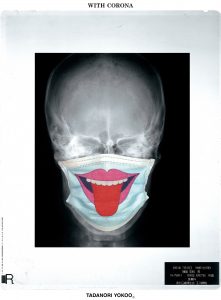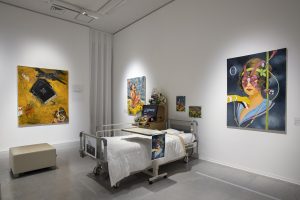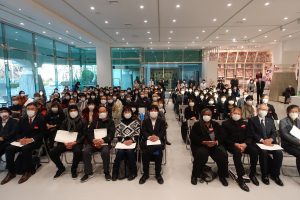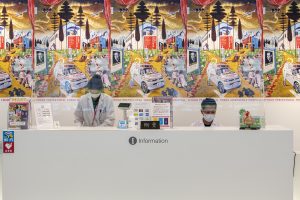
June 25, 2021
“Hyogo Prefectural Yokoo Emergency Hospital” Exhibition at Yokoo Tadanori Museum of Contemporary Art
Yu Hayashi
Assistant Curator,
Yokoo Tadanori Museum of Contemporary Art
Yokoo Tadanori Museum of Contemporary Art opened in 2012 in the newly renovated west wing of the Hyogo Prefectural Museum of Art’s Oji Branch (former Hyogo Prefectural Museum of Modern Art, designed by Togo Murano). The museum conserves and displays artworks and materials of the artist Tadanori Yokoo, born in Hyogo prefecture. There is no permanent display, but three temporary exhibitions take place per year to present works of this practicing artist from multiple angles and in a progressive way.

The exhibition titled Hyogo Prefectural Yokoo Emergency Hospital, which opened on February 1, 2020, focused on the relation between the artist’s creative activities and the “body.” Yokoo, whose medical record is full of conditions such as asthma, bone fractures, zona, facial nerve paralysis, sudden deafness, and so on, is also known for his declared “passion for hospitals.” For Yokoo, who is acutely sensitive to the body and has a strong interest in physical condition and health, the body has been something more reliable than the spirit and mind. As he says, “The body doesn’t lie. So I do my best to listen to what my body demands, to meet its physiological needs, both in everyday life and in creative activities.” The importance he places on the body is closely linked with his self-definition as an artist who follows his senses or instincts rather than ideas or words.
In this exhibition, with a view to highlighting Yokoo’s approach to the body through his works and documents, an attempt was made to transform the whole museum into a “hospital.” To achieve this, various instruments and furniture such as beds, infusion stands, waiting-room chairs, and information panels for outpatients were acquired from real hospitals and placed throughout the museum. The exhibition was designed to represent departments such as a paediatric department, ophthalmology department, and ear, nose and throat department.

At first, this exhibition was scheduled to run until May 10, but due to the spread of the novel coronavirus infection, we were forced to stop welcoming visitors on March 4 about a month after the opening, and to close our doors for some time. Then, once the state of emergency was proclaimed, we also had to postpone the next exhibition, which led us to extend this exhibition to cover the gap. When the exhibition reopened, we had to ask visitors to sterilize their hands, take their temperature, and fill in a sheet with their contact details as preventive measures against the spread of infection. But it was striking to see how, framed in the context of this exhibition, this routine functioned as if it were a performance coordinated with the exhibition (filling in the contact details sheet took the form of a “medical questionnaire.”)
On the other hand, the experience of the pandemic placed people in such a condition that nobody could help but look at diseases and death in a certain way and think about their own body or those of others, which brought changes in their reaction to this exhibition itself. Though we had not foreseen such a situation occurring when we planned this exhibition, many visitors seemed to find it timely with regard to the reality of society and themselves.

Soon after the museum reopened, Yokoo informed us about his intention to change some exhibition elements as a prompt response to the situation. The updated exhibition began on June 19, with additional works titled With Corona, which explored the image of masks. With Corona is a series of works Yokoo started delivering on May 20, under the state of emergency, through his SNS accounts and the like, that form visual messages full of humor, irony and eeriness, with collages using his own past works, snapshots of everyday life, and press photos, representing oral cavities or masks that could be described as symbols of the coronavirus pandemic. In fact, for the exhibition’s opening ceremony held at the museum on January 31, 2020, before the onset of the pandemic in Japan, Yokoo had already suggested the idea of a performance in which all attendants at the ceremony—including staff members—should wear a mask. At the time it was quite unusual to see a gathering of more than a hundred individuals wearing a mask, but now it can only be described as prophetic as it has become an ordinary daily sight. New works for the With Corona series were delivered on a daily basis and then added to the exhibition progressively. Oddly enough, how those images proliferated in the exhibition space echoed the spread of infection in reality, and it looked as if the exhibition itself was being invaded by “With Corona.”

Although affected by several diseases and injuries, Yokoo, instead of considering these conditions merely as harm to be eliminated, gave free rein to his imagination on their effects and used them as resources for his creative force: an attitude highly instructive in the current situation where many voices are raised that stress the need to coexist with the coronavirus. This exhibition attracted unexpected attention on account of its synchronicity with the pandemic, and faced with a With Corona era that is likely to persist, we hope to keep on exploring activities appropriate to this museum.
(Yu Hayashi)
Yokoo Tadanori Museum of Contemporary Art
The museum was opened in 2012 as a branch of the Hyogo Prefectural Museum of Art, in the newly renovated west wing of the former Hyogo Prefectural Museum of Modern Art (designed by Togo Murano). It also houses the Open Studio that hosts various events such as workshops and concerts, etc., and an archive room (open to the public by appointment) where a huge collection of related documents and materials is stored and classified.